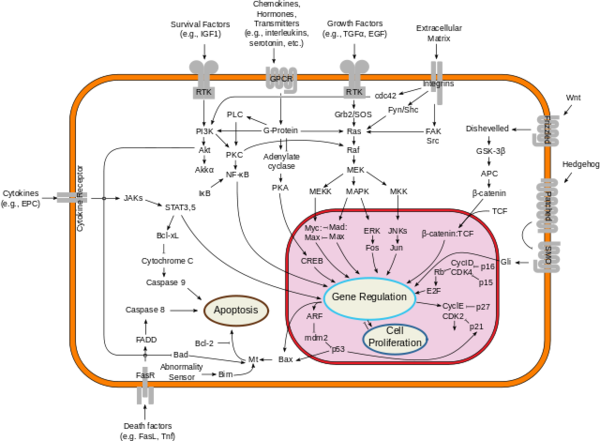Neurofibromin
From Proteopedia
(Difference between revisions)
| Line 4: | Line 4: | ||
== Structure == | == Structure == | ||
| - | + | ||
| - | + | ||
===Domains=== | ===Domains=== | ||
[[Image:Nfdomains2.png|800 px|thumb|Figure 1. Domains of Neurofibromin.]] | [[Image:Nfdomains2.png|800 px|thumb|Figure 1. Domains of Neurofibromin.]] | ||
| Line 15: | Line 14: | ||
The Cysteine-Serine-rich domain (CSRD) and C-terminal domain (CTD) contain phosphorylation sites. The CSRD is able to be phosphorylated by protein kinases A and C. Phosphorylation by protein kinase C is a positive regulator of neurofibromin activity. The CTD is phosphorylated primarily by protein kinase C. This domain is a negative regulator of neurofibromin activity if particular residues are phosphorylated. It also plays an important role in tubulin binding, as it helps in the transition from metaphase to anaphase. CTD contains a nuclear localization signal as well. | The Cysteine-Serine-rich domain (CSRD) and C-terminal domain (CTD) contain phosphorylation sites. The CSRD is able to be phosphorylated by protein kinases A and C. Phosphorylation by protein kinase C is a positive regulator of neurofibromin activity. The CTD is phosphorylated primarily by protein kinase C. This domain is a negative regulator of neurofibromin activity if particular residues are phosphorylated. It also plays an important role in tubulin binding, as it helps in the transition from metaphase to anaphase. CTD contains a nuclear localization signal as well. | ||
===Important Structural Features=== | ===Important Structural Features=== | ||
| - | ==== | + | ====Conformations==== |
| + | Neurofibromin is a dimeric protein that is found in the cytoplasm. It exists in two conformations, <scene name='90/904326/Open_conformation/2'>open</scene> and <scene name='90/904326/Closed_conformation/2'>closed</scene> . The open conformation has one of the protomers in an auto-inhibited conformation and the other in an open conformation. In the <scene name='90/904326/Open_conformation_with_grd_hig/2'>open conformation</scene>, Ras is able to bind to the GRD neurofibromin. The <scene name='90/904326/Grd_closed_conformation/2'>closed conformation</scene> has both protomers in an autoinhibited conformation, which sterically hinders the binding of Ras to GRD. Only one of the protomers has to be in the open conformation for Ras to bind. | ||
| + | ====Ras binding site==== | ||
Ras and Neurofibromin associate through an arginine residue, 1276, that comes from neurofibromin. This arginine is referred to as the [http://https://en.wikipedia.org/wiki/Arginine_finger “arginine finger”] and assists in the hydrolysis of GTP by binding to a backbone carbon atom of tyrosine 32 of Ras when neurofibromin is in the open conformation. It points into the GTP binding site of Ras when neurofibromin is in the open conformation. R1276 also helps stabilize the position of Glutamine 61, a key catalytic residue, through hydrogen bonds. | Ras and Neurofibromin associate through an arginine residue, 1276, that comes from neurofibromin. This arginine is referred to as the [http://https://en.wikipedia.org/wiki/Arginine_finger “arginine finger”] and assists in the hydrolysis of GTP by binding to a backbone carbon atom of tyrosine 32 of Ras when neurofibromin is in the open conformation. It points into the GTP binding site of Ras when neurofibromin is in the open conformation. R1276 also helps stabilize the position of Glutamine 61, a key catalytic residue, through hydrogen bonds. | ||
Revision as of 19:47, 7 April 2022
| |||||||||||
References
- ↑ Bergoug M, Doudeau M, Godin F, Mosrin C, Vallee B, Benedetti H. Neurofibromin Structure, Functions and Regulation. Cells. 2020 Oct 27;9(11). pii: cells9112365. doi: 10.3390/cells9112365. PMID:33121128 doi:http://dx.doi.org/10.3390/cells9112365
- ↑ Naschberger A, Baradaran R, Rupp B, Carroni M. The structure of neurofibromin isoform 2 reveals different functional states. Nature. 2021 Nov;599(7884):315-319. doi: 10.1038/s41586-021-04024-x. Epub 2021, Oct 27. PMID:34707296 doi:http://dx.doi.org/10.1038/s41586-021-04024-x
- ↑ Trovo-Marqui AB, Tajara EH. Neurofibromin: a general outlook. Clin Genet. 2006 Jul;70(1):1-13. doi: 10.1111/j.1399-0004.2006.00639.x. PMID:16813595 doi:http://dx.doi.org/10.1111/j.1399-0004.2006.00639.x
- ↑ Hall BE, Bar-Sagi D, Nassar N. The structural basis for the transition from Ras-GTP to Ras-GDP. Proc Natl Acad Sci U S A. 2002 Sep 17;99(19):12138-42. Epub 2002 Sep 4. PMID:12213964 doi:http://dx.doi.org/10.1073/pnas.192453199
- ↑ Cimino PJ, Gutmann DH. Neurofibromatosis type 1. Handb Clin Neurol. 2018;148:799-811. doi: 10.1016/B978-0-444-64076-5.00051-X. PMID:29478615 doi:http://dx.doi.org/10.1016/B978-0-444-64076-5.00051-X
- ↑ Frech M, Darden TA, Pedersen LG, Foley CK, Charifson PS, Anderson MW, Wittinghofer A. Role of glutamine-61 in the hydrolysis of GTP by p21H-ras: an experimental and theoretical study. Biochemistry. 1994 Mar 22;33(11):3237-44. doi: 10.1021/bi00177a014. PMID:8136358 doi:http://dx.doi.org/10.1021/bi00177a014
- ↑ Bunda S, Burrell K, Heir P, Zeng L, Alamsahebpour A, Kano Y, Raught B, Zhang ZY, Zadeh G, Ohh M. Inhibition of SHP2-mediated dephosphorylation of Ras suppresses oncogenesis. Nat Commun. 2015 Nov 30;6:8859. doi: 10.1038/ncomms9859. PMID:26617336 doi:http://dx.doi.org/10.1038/ncomms9859
- ↑ Lupton CJ, Bayly-Jones C, D'Andrea L, Huang C, Schittenhelm RB, Venugopal H, Whisstock JC, Halls ML, Ellisdon AM. The cryo-EM structure of the human neurofibromin dimer reveals the molecular basis for neurofibromatosis type 1. Nat Struct Mol Biol. 2021 Dec;28(12):982-988. doi: 10.1038/s41594-021-00687-2., Epub 2021 Dec 9. PMID:34887559 doi:http://dx.doi.org/10.1038/s41594-021-00687-2
- ↑ Abramowicz A, Gos M. Neurofibromin in neurofibromatosis type 1 - mutations in NF1gene as a cause of disease. Dev Period Med. 2014 Jul-Sep;18(3):297-306. PMID:25182393
- ↑ Cimino PJ, Gutmann DH. Neurofibromatosis type 1. Handb Clin Neurol. 2018;148:799-811. doi: 10.1016/B978-0-444-64076-5.00051-X. PMID:29478615 doi:http://dx.doi.org/10.1016/B978-0-444-64076-5.00051-X
- ↑ Ly KI, Blakeley JO. The Diagnosis and Management of Neurofibromatosis Type 1. Med Clin North Am. 2019 Nov;103(6):1035-1054. doi: 10.1016/j.mcna.2019.07.004. PMID:31582003 doi:http://dx.doi.org/10.1016/j.mcna.2019.07.004
- ↑ McCubrey JA, Steelman LS, Chappell WH, Abrams SL, Wong EW, Chang F, Lehmann B, Terrian DM, Milella M, Tafuri A, Stivala F, Libra M, Basecke J, Evangelisti C, Martelli AM, Franklin RA. Roles of the Raf/MEK/ERK pathway in cell growth, malignant transformation and drug resistance. Biochim Biophys Acta. 2007 Aug;1773(8):1263-84. doi:, 10.1016/j.bbamcr.2006.10.001. Epub 2006 Oct 7. PMID:17126425 doi:http://dx.doi.org/10.1016/j.bbamcr.2006.10.001
Proteopedia Page Contributors and Editors (what is this?)
Jordyn K. Lenard, Ryan D. Adkins, Michal Harel, OCA, Jaime Prilusky


